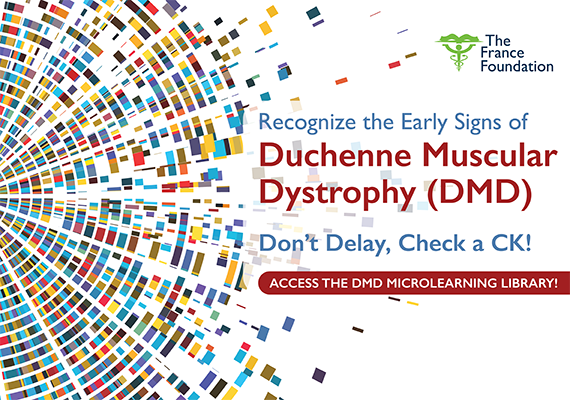Diagnosing Duchenne Muscular Dystrophy Without Delay
Information provided by The France Foundation
As the treatment landscape for Duchenne Muscular Dystrophy (DMD) continues to advance, including the approval of gene therapy options, the early diagnosis of patients is more critical than ever to maximize the benefits of treatment. Recently published clinical findings that compare patient cohorts from 1982-2000 to 2000-2015 show the time interval between first signs of DMD and diagnosis remains unchanged at 2.2 years. Clinicians and caretakers do not often recognize the hallmark symptoms, and creatine kinase (CK) testing is not performed until after these symptoms are first noticed. Given the age limit for patients who could qualify for gene therapy, finding differences in motor function, recognizing delays in reaching developmental milestones, and taking the concerns of parents and guardians into account have the potential to help a patient receive life-changing treatment for this rare disease.
Family physicians and pediatricians are at the forefront of the ongoing endeavor to identify DMD, refer appropriately, and support the overall treatment of patients. They are often the first clinicians to ever see a patient living with DMD, whether they realize it at the time of an appointment or later with the gift of hindsight. Unfortunately, it’s not always easy to see the full scope of a patient’s health during a 30-minute appointment every three to six months. Providing the best care possible in the moments when it matters most comes down to learning what signs and symptoms to look for and what next steps to take when DMD is suspected.
In this microlearning library, you have the opportunity to learn about the early signs and symptoms of DMD, the best methods when referring a patient who may have DMD, and the ongoing role of family physicians and pediatricians in DMD management. Combating the progression of this rare disease requires a skilled multidisciplinary team and a shared decision-making approach to support patients and their families. From family physicians to neuromuscular specialists, each clinician plays a vital role in the treatment of patients with DMD. With the resources found in this microlearning library, family physicians can provide practical insights on treatment plans and share management strategies tailored to their patients’ individual needs, which will ultimately help to preserve the patients’ quality of life for years to come.
Disclaimer
The posting of sponsored information and content on this page should not be considered an AAFP endorsement or recommendation of the sponsor's products, services, policies, or procedures. The information and opinions expressed on this page are those of the paid sponsors and do not necessarily reflect the view of the AAFP. The AAFP is not responsible for the content of third-party websites linked from this page; moreover, any links on this page to third-party websites where goods or services are advertised are not endorsements or recommendations by the AAFP of the third-party sites, goods, or services.
